
Hutheesing Jain Temple – I told my cab driver on a fine Sunday morning. He asked me where it is and I wondered about his basic knowledge of the city. I checked the address on Google and said Madhupura. He laughed and said – Oh Hatheesing ni Wadi, say it like that na. A classical example of the local vs visitor to the city.
Anyway, we reached and parked the car in a neat and clean parking next to a Jain Museum. On one side was a dharamshala where Jains can use to stay when visiting the city. You obviously get the Satvik Jain food when you stay here at a reasonable rate.
On the right I could see a tall Stambha or pillar standing alone with an uncanny resemblance to the Vijay and Kirti Stambha at Chittorgarh Fort.
As I turned around the temple stood their majestically.
History of Hutheesing Jain Temple
As the name itself tells, the temple belongs to the Jain family of Hutheesing Kesarising, who was a businessman who lived in mid-19th CE. Though he started building this temple, he died young at the age of 49. The construction of the temple was then completed by his young wife Harkunwar Sethani.

A legend tells that the workers who were sculpting the stone were doing a not so fine work. When the Sethani Harkunwar found out, she spoke to the workers. They tell her that they were paid by the size of stone sculpted and fine work takes time. She told them to do the fine sculpting and bring to her the stone chipped off and they would be paid in equivalent gold.
Is this not a perfect case study of incentivizing excellence?
Another legend says that the temple was built at the time of a severe famine and draught. It provided employment to many craftsmen for a period of two years.
It is said that in those days the temple costed about Rs 12 Lakhs. The Consecration of the temple at the hands of Sh Shantisagar Suri ji was attended by more than one lakh people who came from villages near and far. Arrangements for their stay were made behind the temple that is still known as Hatheepara.
Architecture of Huteesing Jain Temple
The temple follows a curious mix of Maru-Gurjara style of architecture that is prevalent in this part of the country but with a dash of Haveli style. Premchand Salat was the architect of this temple.
At first look, it reminded me of the Ranakpur Jain Temple near Udaipur.
You enter the temple through a porch that is jetting out like you see in colonial bungalows. However, the sculpted pillars, arches or torans and the jharokhas on the first floor will port you to Rajasthan instantly. You enter through a doorway that has a typical Jain temple doorjamb – finely sculpted.
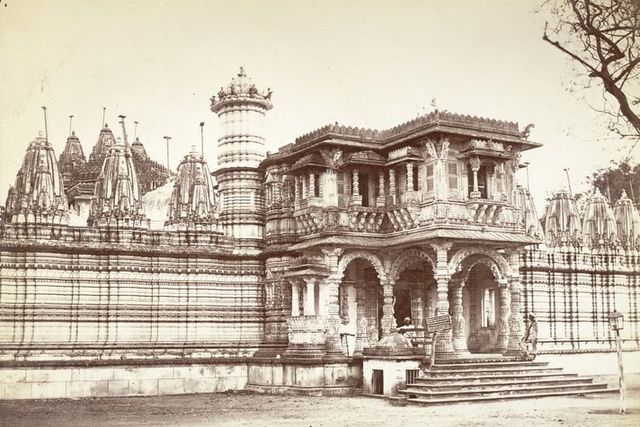
Inside you see a temple in the middle of a courtyard, surrounded by a prakara wall with a pillared courtyard running all along it. There are 52 smaller temples called Dev Kulika. Each of them has Murtis of three or more Tirthankaras, 20 of whom belong to past and future Tirthankaras. As you walk you can see them through various arched openings. Each of them temples have the small Shikharas on top.
Main Temple
The main temple, called Hutheesing Nu Derasar, stands on a platform in the middle of the courtyard. Of the three storeys of the temple, you enter the middle one through a flight of stairs. You first land in the Puja Mandapa and then move towrds Rang Mandapa. From here you see the garbhagriha with three doors. Inside there are stone and metal murtis of different Tirthankaras. The main Murti is that of 15th Tirthankar Shri Dharamnath Bhagwan, the Mool Nayak of this temple.
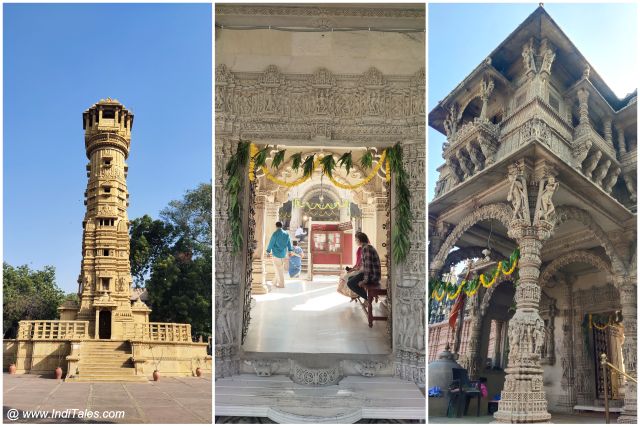
From one corner of temple, another flight of steep steps take you to the first floor. There is another garbhagriha here with murtis of many Jain Tirthankaras. You can see the view of the temple from here as you walk along the dome of the mandapas below.
There is an underground level too where Jain Murtis are installed. You can enter it from one side and come out from another.
The walls are full of Jali or latticed windows. Each window has a different design, mostly geometrical, but some floral as well. It reminded me of Jali patterns of Paigah Tombs in Hyderabad and the windows of Hoysala temples of Karnataka.
There are Madanika figures on the exterior walls as well as the ceiling of the shikhara inside the temple. You can see them playing different musical instruments or in dancing poses. They create an environment of Utsava or celebration.
Other Features
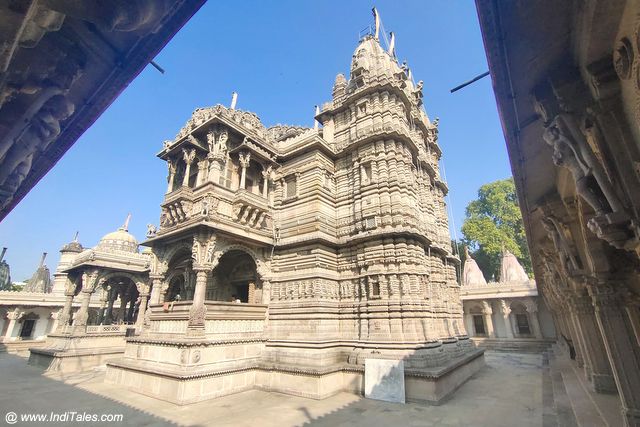
Overall, the temple contains 450 Jinalayas in the temple complex. There is a Pratima of Osian Devi, the kuldevi of Oswals too at the temple. Remember, Sethani Harkunwar came from Oswal community.
In the corner as you move towards the door to exit, you see a huge underground well that is covered with a copper lid. This is the inbuilt rainwater harvesting system. You can see this across the Pol area of Ahmedabad.
You get a good view of the temple architecture as you take a parikrama or circumambulation around the temple.
Manstambh
The tall Stambh in front of the temple is the Manstambh. It was built to commemorate the 2500th birth anniversary of Mahavir ji in 2003. A Pratima of Mahavir ji is enshrined here.
As you go around the temple, you admire the carving on exterior wall. At the back is a park that has a labyrinth made in it. It was closed when I visited but my friend told me that in their childhood they used to play here.
Museum
The lovely museum is located close to the car parking. Right outside you can see the artifacts depicting Jain cosmology. There is a small entry ticket and a slightly larger camera ticket.
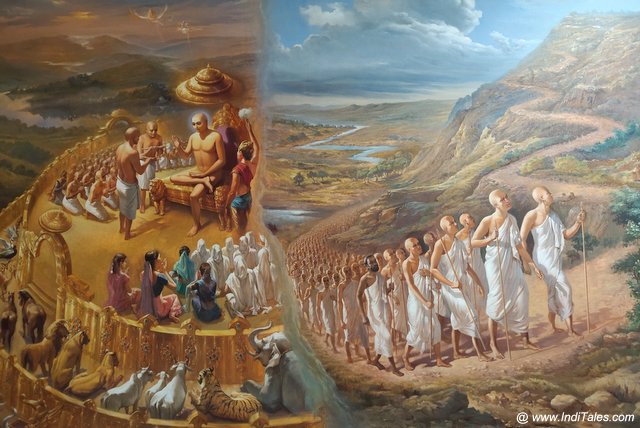
Displays at the two levels of the museum take you through the various stories of the Jain Dharma. It tells stories of the Tirthankaras and of Acharyas inclusing the ones who gave us the first written texts.
Walking through the museum is like educating yourself on Jainsim. Top floor of this building houses a library.
Paryushan and Mahavir Jayanti are the key festivals celebrated in the temple. Diwali, which is the day of Nirvana of Bhagwan Mahavir is also celebrated.
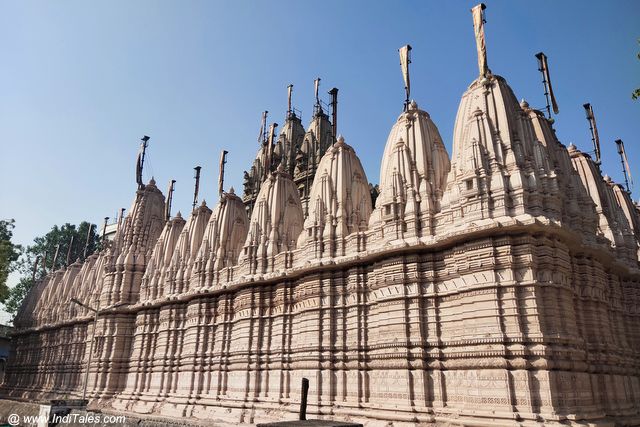
The temple is managed by Shri Hutheesing Kesarising Trust.
Travel Tips for Hutheesing Jain Temple
Huteesing Jain Temple is in the old city of Ahmedabas close to Delhi Darwaza.
Temple is open from 8 AM to 5 PM.
Photography is allowed outside but not inside.
Temple is free but museum has a nominal fee.
It is crowded on weekends when many families come for rituals, but is usually quiet and peaceful on most other days.
If you are spending a day in the old city of Ahmedabad, you can easily spend an hour or so at Huthessing Jain temple and museum.
Discover more from reviewer4you.com
Subscribe to get the latest posts to your email.




